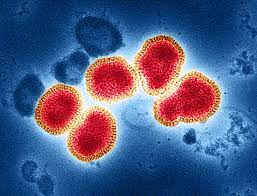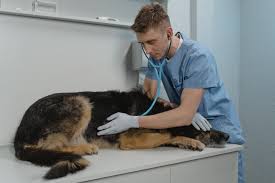Understanding Canine Influenza: H3N2 and H3N8 Strains, Symptoms, and Safeguarding Your Dog’s Health
Dogs can contract certain types of influenza viruses, but the strains that typically affect dogs are different from those that affect humans. In general, the influenza viruses that affect dogs are not the same as the human seasonal flu viruses, and they are not known to be easily transmitted between humans and dogs.
Influenza Viruses in Dogs vs. Humans:


Influenza viruses are a diverse family of viruses capable of infecting various animal species, including both humans and dogs. However, one of the key distinctions lies in the specific strains that affect these two groups. When we examine the strains responsible for influenza in dogs, they are notably different from the ones that trigger the seasonal flu in humans.
In the canine world, the virus responsible for influenza is known as the Canine Influenza Virus (CIV). This virus comes in two recognized strains: H3N2 and H3N8. These strains have evolved to target dogs specifically and have adapted to the canine respiratory system. On the other hand, the influenza viruses that predominantly affect humans are typically classified into two main types: influenza A and influenza B. Within these types, numerous subtypes exist, including H1N1 and H3N2, among others, which are responsible for various flu outbreaks in the human population.
let’s delve deeper into Canine Influenza Virus (CIV), specifically the H3N2 and H3N8 strains, their effects on dogs, how to identify symptoms, and what to do if your dog displays signs of infection.

| H3N2 Canine Influenza Virus | H3N8 Canine Influenza Virus |
| H3N2 is a subtype of the influenza A virus that specifically affects dogs. This strain of CIV first emerged and was identified in dogs in Asia, particularly in South Korea, in the early 2000s. However, it’s essential to note that H3N2 is not limited to the region of its initial discovery; it has since spread to various parts of the world, including the United States and other countries. Symptoms and Effects: H3N2 primarily targets a dog’s respiratory system, which can lead to a range of symptoms, from mild to severe. Here’s a breakdown of the effects and symptoms associated with H3N2: Respiratory Distress: Dogs infected with H3N2 commonly exhibit respiratory symptoms, such as persistent and sometimes severe coughing. This cough is often dry and hacking, similar to kennel cough, but it can progress to a more productive cough with mucus. Sneezing and Nasal Discharge: Another hallmark of H3N2 infection is sneezing and nasal discharge. This discharge can range from clear to thick and yellowish, and it may be accompanied by a runny or stuffy nose. Fever: Many dogs infected with H3N2 develop a mild to moderate fever. An elevated body temperature is a common sign of the immune system responding to the viral infection. Lethargy and Reduced Appetite: Infected dogs may display signs of lethargy, which means they become less active and more sluggish than usual. Additionally, they may show a decreased interest in food and water. Pneumonia (in Severe Cases): While most cases of H3N2 result in mild to moderate symptoms and recoveries, in some instances, particularly if the infection is left untreated or if the dog has an underlying health condition, it can progress to pneumonia. Pneumonia is a more severe condition that involves inflammation and infection of the lungs. Symptoms of pneumonia in dogs include severe coughing, difficulty breathing, a bluish tinge to the mucous membranes, and a more critical illness overall. Vulnerable Groups: It’s important to note that certain groups of dogs are more susceptible to severe illness caused by H3N2. These include young puppies, elderly dogs, and dogs with weakened immune systems due to preexisting health issues. In these cases, H3N2 can be particularly concerning, and early detection and treatment are critical. Overall, while H3N2 can cause significant discomfort and health challenges for dogs, especially in severe cases, most dogs recover with appropriate care and veterinary intervention. However, vigilance in monitoring for symptoms and seeking prompt medical attention are essential to ensure the best possible outcome for your canine companion if they become infected with H3N2. | H3N8 was initially an equine influenza virus that adapted to dogs in the early 2000s. It was first recognized in racing greyhounds but has since been found in various dog breeds. Symptoms of H3N8 in dogs resemble those of H3N2 and include coughing, sneezing, nasal discharge, fever, and lethargy. As with H3N2, severe cases can lead to pneumonia. Origins and Adaptation: H3N8 originally emerged as an equine influenza virus, primarily affecting horses. However, in a rare instance of cross-species transmission, this virus adapted to dogs, marking a significant development in the world of canine health. The initial recognition of H3N8 in dogs occurred in racing greyhounds, raising concerns within the canine community. Subsequently, the virus has been detected in various other dog breeds, highlighting its capacity to spread among the domestic dog population. Symptoms and Effects: H3N8 CIV shares several key characteristics with H3N2 CIV, particularly in terms of the symptoms it can induce in infected dogs. Here’s a closer look at the effects and symptoms associated with H3N8: Respiratory Distress: Dogs infected with H3N8 frequently display respiratory symptoms, including a persistent and sometimes severe cough. This cough is typically dry and hacking in the early stages but can progress to a more productive cough with the presence of mucus. Sneezing and Nasal Discharge: Like H3N2, H3N8 often causes sneezing and nasal discharge. The discharge may vary from clear to thick and yellowish, and it can be accompanied by a runny or stuffy nose. Fever: Many dogs infected with H3N8 develop a fever as part of their immune response to the viral infection. A heightened body temperature is a common sign of an active infection. Lethargy and Reduced Appetite: Infected dogs may experience lethargy, becoming less active and more subdued than usual. Additionally, they may lose interest in their food and water, leading to reduced appetite. Pneumonia (in Severe Cases): While most cases of H3N8 result in mild to moderate symptoms and recoveries, severe cases can progress to pneumonia, a serious condition characterized by inflammation and infection of the lungs. Symptoms of pneumonia in dogs include severe coughing, labored breathing, a bluish tinge to the mucous membranes, and an overall more critical illness. H3N8 CIV’s emergence from the equine population to dogs serves as a reminder of the complex nature of viral diseases and their potential to adapt to new hosts. While H3N8 CIV can cause significant discomfort and health challenges in infected dogs, early detection, proper veterinary care, and supportive measures like rest and hydration can contribute to a positive outcome. Monitoring your dog for symptoms and seeking timely medical attention when needed remain essential practices to ensure the well-being of your canine companion in the face of this particular strain of Canine Influenza Virus. |
Always consult Veterinarian before administering any medication or remedies
If you suspect your dog may have CIV or exhibits any of the symptoms mentioned above, it’s crucial to take the following steps:
Isolate Your Dog: Separate your sick dog from other dogs to prevent potential transmission.
Contact Your Veterinarian: Prompt communication with your veterinarian is critical when you suspect your dog may have CIV or if they display symptoms associated with influenza. Here’s why this step is so crucial. Upon contacting your veterinarian, they will likely conduct an initial assessment of your dog’s condition over the phone. Based on the information you provide and the symptoms described, they will advise you on the best course of action. One primary recommendation may be to bring your dog in for a thorough examination. In some cases, this may involve testing for CIV to confirm the diagnosis. Testing typically includes a nasal or throat swab, which is then analyzed for the presence of the virus. Confirmation is essential as the symptoms of CIV can resemble those of other respiratory illnesses in dogs. Once diagnosed, your veterinarian will discuss potential treatment options. This can include antiviral medications to target the influenza virus directly. Additionally, if a secondary bacterial infection is present, antibiotics may be prescribed to address that aspect of the illness. The specific treatment plan will depend on the severity of your dog’s condition and their overall health.

Fluids and Rest: Hydration and rest are vital components of a dog’s recovery from CIV. Here’s why they matter. Encourage your dog to drink water regularly. In many cases, dogs with influenza may become dehydrated due to fever, reduced appetite, and fluid loss from sneezing or coughing. Adequate hydration helps maintain their overall well-being and supports the body’s ability to fight off the infection. Provide a quiet and comfortable space for your dog to rest. Like in humans, rest is essential for recovery. Create an environment that minimizes stress and disruption, allowing your dog to recuperate more effectively.
Preventive Measures:
Taking steps to prevent CIV is crucial, especially if you live in an area with a history of outbreaks or if your dog is at higher risk. Here’s how to approach prevention:
Discuss vaccination options with your veterinarian. Canine influenza vaccines are available and can help protect your dog from contracting the virus or reduce the severity of symptoms if they do become infected. Your veterinarian can provide guidance on the best vaccination schedule and approach based on your dog’s age, health status, and lifestyle.
Beyond vaccination, practicing good hygiene and minimizing contact with other dogs during flu outbreaks can also reduce the risk of exposure. This includes avoiding crowded dog parks or areas where dogs congregate when outbreaks are reported.
Remember that most dogs recover from CIV with proper care, but early detection and treatment are essential to ensure a swift and complete recovery. Always consult your veterinarian for guidance tailored to your dog’s specific condition and needs.
This differentiation in virus strains emphasizes the fundamental divergence between canine and human influenza. While both groups can contract influenza, the unique strains and their adaptations to distinct host species underscore the limited overlap between the two, thereby influencing the dynamics of transmission and infection. It’s essential to recognize these differences to better understand the specific risks and behaviors associated with each type of influenza.

Moreover, the species specificity of influenza viruses plays a pivotal role in limiting transmission between humans and dogs. These viruses typically rely on specific receptors in the host’s respiratory tract to infect cells. The presence of different receptors in humans and dogs significantly hampers the ability of the virus to move efficiently from one species to another. Consequently, despite the occasional isolated cases where dogs have tested positive for influenza strains related to human flu, like H1N1 or H3N2, such instances are infrequent. The transmission of these human-related strains to dogs, or vice versa, is not known to occur commonly. Hence, the inherent species barrier further minimizes the risk of inter-species transmission, ensuring that the primary concern remains the health and well-being of both humans and their canine companions.






